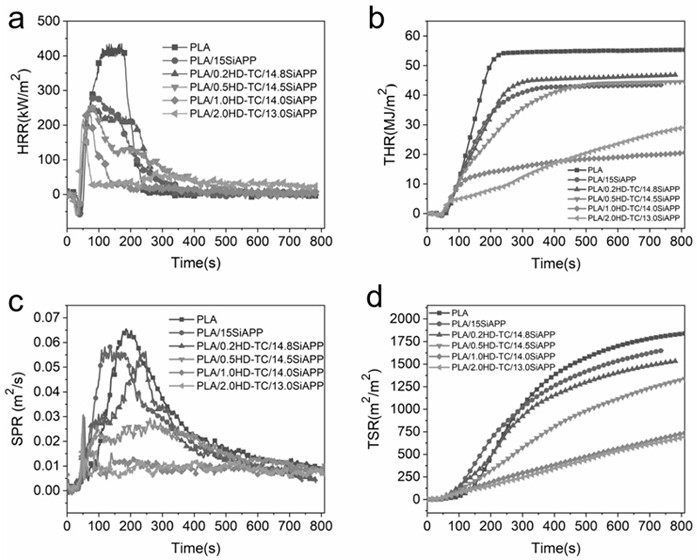Low-smoke flame-retardant polylactic acid composite material and preparation method thereof
A composite material and low-smoke flame-retardant technology, which is applied in the field of low-smoke flame-retardant polylactic acid composite materials and its preparation, can solve the problems of ammonium polyphosphate's smoke-suppressing and poison-reducing effect not being obvious, and achieve good application prospects and low preparation costs , The effect of simple production process
- Summary
- Abstract
- Description
- Claims
- Application Information
AI Technical Summary
Problems solved by technology
Method used
Image
Examples
preparation example Construction
[0026] The preparation steps of the ammonium polyphosphate of silica gel microencapsulation are as follows:
[0027] a. Add 150 ml of absolute ethanol and 50 ml of deionized water into a three-necked flask, stir and mix mechanically and heat up to 45°C to obtain solution A;
[0028] b. Add 50 grams of ammonium polyphosphate and 0.5 grams of emulsifier OP-10 into solution A, and add a certain amount of ammonia water to adjust the pH of the solution to 9-10, and mechanically stir the mixed solution for 5 minutes to obtain solution B;
[0029] c. Slowly add 10 grams of tetraethyl orthosilicate to solution B within 30 minutes, then mechanically stir for 4 hours to obtain solution C;
[0030] d. After solution C is cooled, filter it, then wash the solid with deionized water and absolute ethanol, and dry the solid in a drying oven at 80°C for 24 hours to obtain silica gel microencapsulated ammonium polyphosphate (SiAPP).
[0031] The preparation steps of the titanium carbide nanosh...
Embodiment 1
[0038] A low-smoke flame-retardant polylactic acid composite material is prepared according to the following specific steps:
[0039] a. Weigh 0.2 parts of cetyl dimethyl benzyl ammonium chloride functionalized modified titanium carbide nanosheets, 14.8 parts of ammonium polyphosphate and 85 parts of polylactic acid microencapsulated by silica gel;
[0040] b. place the ammonium polyphosphate and polylactic acid of the hexadecyl dimethyl benzyl ammonium chloride functionalized modified titanium carbide nanosheets, the silica gel microcapsules in the internal mixer, at 180 Mixed at 100°C for 10 minutes, then placed the sample after banburying in a flat vulcanizing machine at 180°C for hot pressing to obtain a low-smoke and flame-retardant polylactic acid composite (PLA3).
Embodiment 2
[0042] A low-smoke flame-retardant polylactic acid composite material is prepared according to the following specific steps:
[0043] a. Weigh 0.5 parts of cetyl dimethyl benzyl ammonium chloride functionalized modified titanium carbide nanosheets, 14.5 parts of ammonium polyphosphate and 85 parts of polylactic acid of silica gel microencapsulation;
[0044] b. place the ammonium polyphosphate and polylactic acid of the hexadecyl dimethyl benzyl ammonium chloride functionalized modified titanium carbide nanosheets, the silica gel microcapsules in the internal mixer, at 180 Mixed at 100°C for 10 minutes, and then put the sample after banburying into a flat vulcanizing machine at 180°C for hot pressing to obtain a low-smoke and flame-retardant polylactic acid composite (PLA4).
PUM
 Login to view more
Login to view more Abstract
Description
Claims
Application Information
 Login to view more
Login to view more - R&D Engineer
- R&D Manager
- IP Professional
- Industry Leading Data Capabilities
- Powerful AI technology
- Patent DNA Extraction
Browse by: Latest US Patents, China's latest patents, Technical Efficacy Thesaurus, Application Domain, Technology Topic.
© 2024 PatSnap. All rights reserved.Legal|Privacy policy|Modern Slavery Act Transparency Statement|Sitemap



